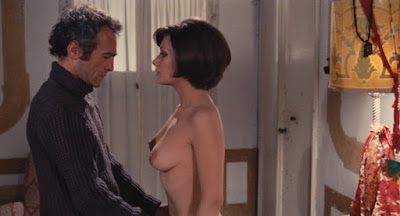It’s also, for various reasons, a key entry in Franco’s filmography.
A young girl has been murdered in the village of Holfen, and another has disappeared. There are rumours among the villagers that the Baron von Klaus has been up to his old tricks. But which Baron von Klaus? Is it the notorious 17th century baron, who tortured a killed a number of girls, or one of his currently living descendants? The original baron was cursed by the father of one of his victims and supposedly his spirit still haunts the district. There are those who claim to have seen him.
It’s also, for various reasons, a key entry in Franco’s filmography.
A young girl has been murdered in the village of Holfen, and another has disappeared. There are rumours among the villagers that the Baron von Klaus has been up to his old tricks. But which Baron von Klaus? Is it the notorious 17th century baron, who tortured a killed a number of girls, or one of his currently living descendants? The original baron was cursed by the father of one of his victims and supposedly his spirit still haunts the district. There are those who claim to have seen him.
A young girl has been murdered in the village of Holfen, and another has disappeared. There are rumours among the villagers that the Baron von Klaus has been up to his old tricks. But which Baron von Klaus? Is it the notorious 17th century baron, who tortured a killed a number of girls, or one of his currently living descendants? The original baron was cursed by the father of one of his victims and supposedly his spirit still haunts the district. There are those who claim to have seen him.
The von Klaus family lives, fittingly, in a gothic pile surrounded by swamp land. There’s the heir to the tile, Ludwig, and his financée. There’s his mother, who is dying. And there is his uncle, Max von Klaus (Howard Vernon). The mother wants her son to get away from Holfen before the curse catches up to him, one way or another.
Inspector Borowski (Georges Rollin) is on the case and he’s brimming with confidence. He doesn’t intend to pay any attention to nonsense like ghosts and curses. He doesn’t want any help but a reporter named Karl (from Maidens and Murderers magazine) is determined to help him anyway. He might also be able to get some help from a couple of wood-cutters who seem to know a lot about the von Klaus legend.
More murders follow. There are quite a few women who might be in line to be among the next victim. There’s Ludwig’s fiancée Karine (Paula Martel), there’s Max’s mistress Lida (Ana Castor), and there’s the sexy Margaret who works at the hotel that seems to have a link with the killings. So the audience has three women in danger to worry about. And the inspector has not ruled out the possibility that the murderer is a woman. He has ruled out the possibility that the murderer is a ghost, but whether his confidence on that point is justified remains to be seen.
While this is a conventionally made movie without the stylistic excesses of later Franco it is a bit unusual (for 1962) in its overt blending of horror and eroticism. It’s also in some ways a precursor of the giallo genre. It even features a sinister black-gloved figure who may be the killer! Whether this movie will turn out to be more gothic horror or more giallo is something you’ll have to watch it to find out.
Franco favourite Howard Vernon gives a fine performance as Max, a character who isn’t quite sinister but you get the feeling that maybe he could be. Ludwig von Klaus is just as ambiguous and Hugo Blanco does a fine job with the rôle. The acting in general is very decent.
By the halfway stage you might be thinking that this movie is incredibly restrained for a Franco movie but the director’s trademark interests in perverse sex with strong sadomasochistic overtones gradually become more apparent and in the later stages we get a couple of scenes including a dungeon sequence that must have really shocked audiences in 1962. And while there’s not much nudity by later Franco standards, there’s a lot by the standards of 1962. Even at this early stage of his career Franco was pushing the boundaries.
This movie was shot in black-and-white in the 2.35:1 aspect ratio. If you associate the name Jess Franco with a technically slapdash approach you may be quite surprised by this one. It’s technically very proficient and very professional. And there are no zooms. There’s some nice moody location shooting.
The biggest problem with The Sadistic Baron von Klaus is that it’s a bit too slow and a bit too long. Once it gets going it does deliver the goods however. What’s most significant about it is that for the first time we see the overt influence of de Sade. It also features the first really full-blown Franco erotic visual set-piece. If you’re a serious Francophile that makes it essential viewing. Highly recommended.






.jpg)
.jpg)
.jpg)
.jpg)





















.jpg)
.jpg)
.jpg)
.jpg)

.jpg)
.jpg)
.jpg)
.jpg)




